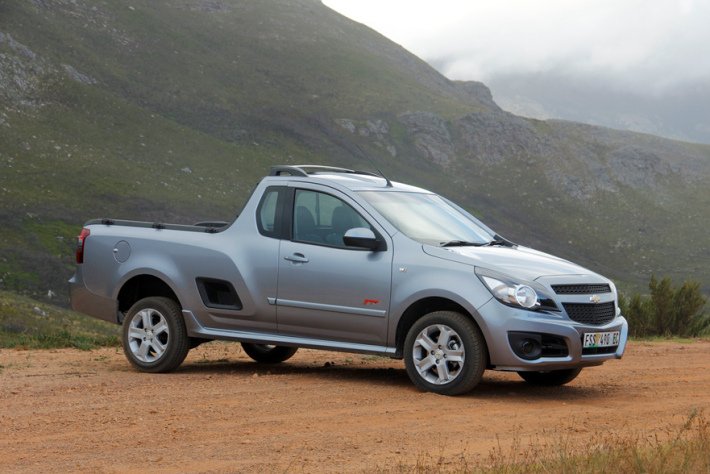
Chevrolet has won the battle in the single cab class with its Utility bakkie. Not only is it the best selling half-ton bakkie, the Utility is also General Motors' number 1 motor vehicle in South Africa. But how has GM turned Chevy, an otherwise not so popular marquee in SA, into the behemoth that it is today, with a total 17 470 units of its bakkie sold in 2013 alone! We detailed the Ute and other bakkies in this article, but here, we of just this Chevrolet bakkie's 2013 sales.
All of the five best selling model derivatives on bakkies sold in the country last year where single cabs. Sure, the Toyota Hilux was the overall king, but its most popular variant was the Hilux 2.0 VVT-i, and at just 3579 units, the Chevy Utility 1.4 with aircon's 5753 sales was a long way ahead of the mighty Hilux, which itself is a single cab variant. But what makes the Utility such a might force? There are many answers to that, but the most obvious have been the following.
In 2011, Ford restructured its entire business. New models of cars where rolled out, and some discontinued. The success of the Ford F Series in the USA prompted the local operations to come up with something of similar stature. A bakkie that would go head on to challenge Toyota's dominance. The result was the Ford Ranger, which sadly has no relation to Chuck Norris, the Texas Ranger. Focusing on new lines meant the discontinuation of the Ford Bantam. That workhorse of a small bakkie that had driven South Africans for over two decades. At the same time, the American parent of GM in Detroit was going through some rough times, and needed a jolt of creativity to get it back on its feet. The answer in South Africa was the Opel Corsa Utility. Although it floundered and fell as it crawled up like a young toddler back when it was first launched in 2011, this Opel Corsa bakkie, later changed to the Chevrolet Corsa Utility, and now just Chevrolet Utility, yeah we know, had a market opened to it. The Opel Corsa Utility was already an erstwhile member of the elite club when it was replaced with a Chevrolet badge and came in as a bigger bakkie with an overall length of 4.514m and widening by a few millimetres too. It's a real pickup, with payload between 733kg and 763kg. Today, the Chevy Utility is the country's number one, and with no sight to lose the gains its made since. Or is it?
The Utility's closest rival is the Nissan NP200. Chevy's offering beats Nissan's by less than 500 units. Here is the closest race in the bakkie market – a market that accounts for over 25% of South Africa's vehicle market. What makes these two so popular is their utility. They're work cars. They're also play cars. I mean, the Chevy Utility can be spotted on one popular music video among our urban youth. The 1.4's engine is obviously smaller than its closest rival, the NP200 1.6. But when you can get just about the same amount of performance in the Chevy, with 68 kW of power, as much as you would in the Nissan bakkie, whose engine can produce a max 64 kW of power. The best thing about the Ute is that its on average a few thousands cheaper, and offers way more on the looks department than the NP200, which seems we can argue still competes with the old Corsa Utility in its exterior. It's just not bold enough.
Although the Chevy Utility is great, it seems to try too hard to impress you than the NP200 does, or maybe it's just that the NP200 isn't even trying. At the end of the day however, South Africans have favoured the former over the latter, and the race is closer even still. In the first three months of 2014, the Chevrolet Utility has already gained a footing with 4254 bakkies sold, while the Nissan NP200 lags at 4092 sales.
Between 2004 and 2009, the then Opel Corsa Ute had sold over 100 thousand units. That's a staggering amount of cars, but it also reflect the boom days before the burst of well 2009, that saw South Africa's first recession in over two decades. The overall bakkies market is still not at those peaks, but the Chevrolet Utility has done exceptionally well to retain good numbers.
Follow Updates on Twitter
Author: Pierre Theron
Recent Articles
Buying a used luxury vehicle - is it worth the maintenance costs?
Exceptional Technical Knowledge and Service from Ravenol Engine Oil Specialist.
Buying or Selling a car - useful tools.
Is pawning your car a good idea if you're in a pinch?
Best Car Sales in South Africa for July, August and September 2015
When Are Used Cars The Cheapest
20 Best Selling Cars and Bakkies in South Africa June 2015
Best Car Buys in South Africa: May vs April 2015
Chip Tuning a turbo diesel, my experience with ECU remapping or 'Chipping'
